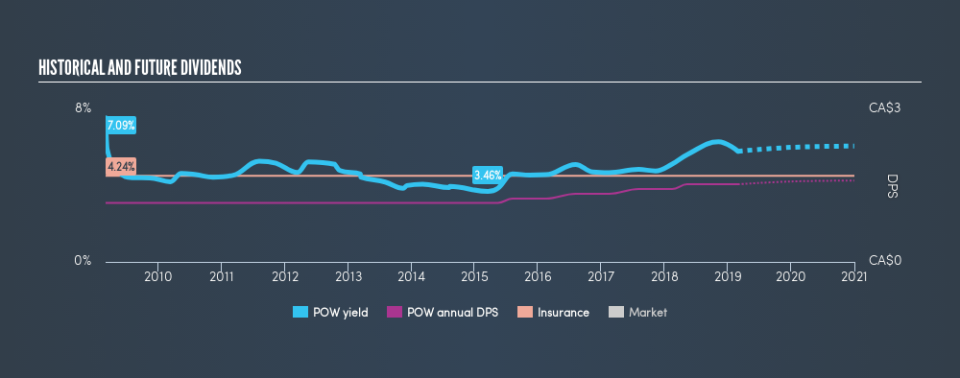Read This Before Considering Power Corporation of Canada (TSE:POW) For Its Upcoming CA$0.38 Dividend

On the 29 March 2019, Power Corporation of Canada (TSE:POW) will be paying shareholders an upcoming dividend amount of CA$0.38 per share. However, investors must have bought the company’s stock before 07 March 2019 in order to qualify for the payment. That means you have only 4 days left! What does this mean for current shareholders and potential investors? Below, I will explain how holding Power of Canada can impact your portfolio income stream, by analysing the stock’s most recent financial data and dividend attributes.
Check out our latest analysis for Power of Canada
How I analyze a dividend stock
When researching a dividend stock, I always follow the following screening criteria:
Is it paying an annual yield above 75% of dividend payers?
Has it paid dividend every year without dramatically reducing payout in the past?
Has the amount of dividend per share grown over the past?
Is is able to pay the current rate of dividends from its earnings?
Will the company be able to keep paying dividend based on the future earnings growth?
Does Power of Canada pass our checks?
Power of Canada has a trailing twelve-month payout ratio of 54%, which means that the dividend is covered by earnings. In the near future, analysts are predicting lower payout ratio of 45% which, assuming the share price stays the same, leads to a dividend yield of around 5.7%. However, EPS should increase to CA$3.55, meaning that the lower payout ratio does not necessarily implicate a lower dividend payment.
If you want to dive deeper into the sustainability of a certain payout ratio, you may wish to consider the cash flow of the business. Companies with strong cash flow can sustain a higher payout ratio, while companies with weaker cash flow generally cannot.
If dividend is a key criteria in your investment consideration, then you need to make sure the dividend stock you’re eyeing out is reliable in its payments. POW has increased its DPS from CA$1.16 to CA$1.53 in the past 10 years. During this period it has not missed a payment, as one would expect for a company increasing its dividend. These are all positive signs of a great, reliable dividend stock.
In terms of its peers, Power of Canada produces a yield of 5.4%, which is high for Insurance stocks but still below the market’s top dividend payers.
Next Steps:
With these dividend metrics in mind, I definitely rank Power of Canada as a strong income stock, and is worth further research for anyone who considers dividends an important part of their portfolio strategy. Given that this is purely a dividend analysis, I recommend taking sufficient time to understand its core business and determine whether the company and its investment properties suit your overall goals. There are three essential aspects you should further research:
Valuation: What is POW worth today? Even if the stock is a cash cow, it’s not worth an infinite price. The intrinsic value infographic in our free research report helps visualize whether POW is currently mispriced by the market.
Management Team: An experienced management team on the helm increases our confidence in the business – take a look at who sits on Power of Canada’s board and the CEO’s back ground.
Other Dividend Rockstars: Are there better dividend payers with stronger fundamentals out there? Check out our free list of these great stocks here.
We aim to bring you long-term focused research analysis driven by fundamental data. Note that our analysis may not factor in the latest price-sensitive company announcements or qualitative material.
If you spot an error that warrants correction, please contact the editor at editorial-team@simplywallst.com. This article by Simply Wall St is general in nature. It does not constitute a recommendation to buy or sell any stock, and does not take account of your objectives, or your financial situation. Simply Wall St has no position in the stocks mentioned. Thank you for reading.

